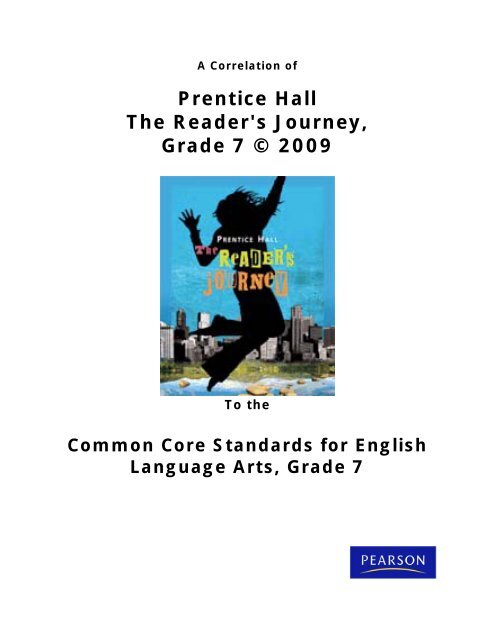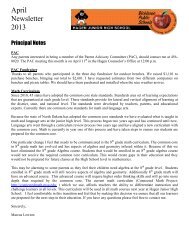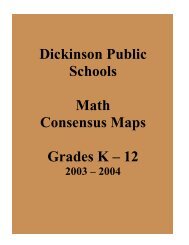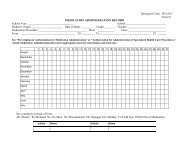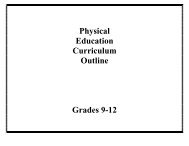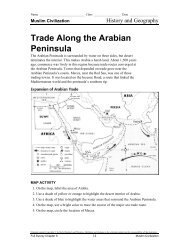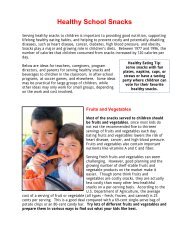Prentice Hall The Reader's Journey, Grade 7 © 2009 - Pearson
Prentice Hall The Reader's Journey, Grade 7 © 2009 - Pearson
Prentice Hall The Reader's Journey, Grade 7 © 2009 - Pearson
Create successful ePaper yourself
Turn your PDF publications into a flip-book with our unique Google optimized e-Paper software.
A Correlation of<br />
<strong>Prentice</strong> <strong>Hall</strong><br />
<strong>The</strong> <strong>Reader's</strong> <strong>Journey</strong>,<br />
<strong>Grade</strong> 7 © <strong>2009</strong><br />
To the<br />
Common Core Standards for English<br />
Language Arts, <strong>Grade</strong> 7
<strong>Prentice</strong> <strong>Hall</strong> <strong>The</strong> <strong>Reader's</strong> <strong>Journey</strong>, <strong>Grade</strong> 7 © <strong>2009</strong><br />
to the<br />
Common Core Standards for English Language Arts, <strong>Grade</strong> 7<br />
INTRODUCTION<br />
This document demonstrates how <strong>The</strong> Reader’s <strong>Journey</strong> meets the objectives of the<br />
Common Core Standards for Language Arts (2010). Correlation page references are to the<br />
Teacher’s Organizer and are cited by activity and page number. <strong>The</strong> Teacher’s Organizer<br />
contains full-size, annotated student pages.<br />
<strong>The</strong> <strong>Reader's</strong> <strong>Journey</strong> is an innovative novel-based Language Arts program dedicated to<br />
making students lifelong readers. <strong>The</strong> program was developed using Grant Wiggins's<br />
Understanding by Design model - a common sense approach for connecting curriculum,<br />
instruction and assessment so students develop deep understanding every day.<br />
Designed for today’s middle school classroom, <strong>The</strong> <strong>Reader's</strong> <strong>Journey</strong> is a standards-based<br />
program that combines the flexibility of a leveled library with the comprehensive curriculum<br />
coverage that has been a hallmark of <strong>Prentice</strong> <strong>Hall</strong> language arts programs. <strong>The</strong> program is<br />
based on leveled novels and readers. Included is a suggested library of 36 titles to meet the<br />
needs of a very wide range of reading abilities within the same grade level. This program is<br />
also flexible. Teachers can select their own novels from a blend of canon, contemporary,<br />
and multi-ethnic novels and high-interest readers.<br />
• Six different readers for each unit<br />
• 1 book at two grades below grade level<br />
• 2 books at one grade below grade level<br />
• 2 books on grade level<br />
• 1 book above grade level<br />
Through <strong>The</strong> <strong>Reader's</strong> <strong>Journey</strong> consumable workbooks, students have access to skills<br />
support, instruction and practice for the basics of a language arts program, and active<br />
reading strategies for struggling and advanced learners alike.<br />
Through <strong>The</strong> <strong>Reader's</strong> <strong>Journey</strong> Teacher’s Organizer, teachers have access to:<br />
• Detailed information about each novel option, including reading levels and sensitive<br />
issues<br />
• Lesson plans including suggested questions and pacing guides<br />
• Library options for ELL students and controlled vocabulary readers for struggling<br />
readers<br />
• Professional development<br />
• Strategies for differentiated instruction<br />
• Transparencies<br />
This document demonstrates the high degree of success students will achieve by using <strong>The</strong><br />
Reader’s <strong>Journey</strong>.<br />
SE = Student Edition<br />
2<br />
TE = Teacher’s Edition
<strong>Prentice</strong> <strong>Hall</strong> <strong>The</strong> <strong>Reader's</strong> <strong>Journey</strong>, <strong>Grade</strong> 7 © <strong>2009</strong><br />
to the<br />
Common Core Standards for English Language Arts, <strong>Grade</strong> 7<br />
Common Core Standards for<br />
English Language Arts, <strong>Grade</strong> 7<br />
<strong>Prentice</strong> <strong>Hall</strong> <strong>The</strong> <strong>Reader's</strong> <strong>Journey</strong>,<br />
<strong>Grade</strong> 7 © <strong>2009</strong><br />
English Language Arts Standards » Reading: Literature » Introduction<br />
<strong>The</strong> following standards offer a focus for instruction each year and help ensure that students gain<br />
adequate exposure to a range of texts and tasks. Rigor is also infused through the requirement that<br />
students read increasingly complex texts through the grades. Students advancing through the<br />
grades are expected to meet each year’s grade-specific standards and retain or further develop<br />
skills and understandings mastered in preceding grades.<br />
<strong>The</strong> CCR anchor standards and high school grade-specific standards work in tandem to define<br />
college and career readiness expectations—the former providing broad standards, the latter<br />
providing additional specificity.<br />
English Language Arts Standards » Reading: Literature » <strong>Grade</strong> 7<br />
Key Ideas and Details<br />
1. Cite several pieces of textual evidence to<br />
support analysis of what the text says explicitly<br />
as well as inferences drawn from the text.<br />
2. Determine a theme or central idea of a text<br />
and analyze its development over the course of<br />
the text; provide an objective summary of the<br />
text.<br />
3. Analyze how particular elements of a story or<br />
drama interact (e.g., how setting shapes the<br />
characters or plot).<br />
Craft and Structure<br />
4. Determine the meaning of words and phrases<br />
as they are used in a text, including figurative<br />
and connotative meanings; analyze the impact<br />
of rhymes and other repetitions of sounds (e.g.,<br />
alliteration) on a specific verse or stanza of a<br />
poem or section of a story or drama.<br />
SE/TE: Questions After Reading/Thinking About<br />
the Selection, 9, 21, 31, 41, 61, 63, 70-71, 73,<br />
79, 99, 111, 125, 127, 129, 135, 155, 157, 165,<br />
167, 171, 205, 283, 289, 290, 297, 303, 305,<br />
309, 333, 339, 341, 343, 345, 351, 383, 395,<br />
412, 423, 433; Reading Skills: Making<br />
Inferences, 148-149, 150; Infer, 9, 63, 71, 135,<br />
165, 229, 395, 423, 433<br />
SE/TE: from “Bronx Masquerade,” 61;<br />
Introduction to the Novel, 100; Comparing<br />
Literary Works: <strong>The</strong>me, 166, 167; “<strong>The</strong> Luckiest<br />
Time of All,” 168-170; Thinking About the<br />
Selection: “An Hour with Abuelo” and “<strong>The</strong><br />
Luckiest Time of All,” 171; Write, 6. Analyze,<br />
343; Reading Skills: Summarizing, 494<br />
SE/TE: Literary Analysis: Narrative Texts, 18-<br />
19; “<strong>The</strong> Medicine Bag,” 20-21; Character, 60-<br />
61; “Stolen Day,” 64-71; Learning About Plot,<br />
112-113; “Rules of the Game,” 114-125;<br />
Characterization, 154-155; “An Hour with<br />
Abuelo,” 158-165; Dialogue and Stage<br />
Directions, 382-383; “Novio Boy,” 386-394,<br />
395; Character Motivation, 410, 411-412; “<strong>The</strong><br />
White Umbrella,” 413-423<br />
SE/TE: Introduction to Prose and Poetry:<br />
Figurative Language, 280-281; Vocabulary<br />
Building Strategies: Connotation and Idioms,<br />
286, 287; Understanding Tone, 290, 291-296,<br />
297; “<strong>The</strong> Trout,” 298-302, 303; Comparing<br />
Literary Works: Figurative Language, 304-305,<br />
306-308, 309; Standardized Test Practice:<br />
Question 6 Connotation/Tone, 321; Literary<br />
Analysis: Sound Devices, Rhythm, and Meter,<br />
326; “Summer,” 327; “Analysis of Baseball,”<br />
328-329; “Wind and Water and Stone,” 330;<br />
“I’ve Had This Shirt,” 332; Thinking About the<br />
Selections, 333; Literary Analysis: Symbolism,<br />
340-341, 342, 343<br />
SE = Student Edition<br />
3<br />
TE = Teacher’s Edition
<strong>Prentice</strong> <strong>Hall</strong> <strong>The</strong> <strong>Reader's</strong> <strong>Journey</strong>, <strong>Grade</strong> 7 © <strong>2009</strong><br />
to the<br />
Common Core Standards for English Language Arts, <strong>Grade</strong> 7<br />
Common Core Standards for<br />
English Language Arts, <strong>Grade</strong> 7<br />
5. Analyze how a drama’s or poem’s form or<br />
structure (e.g., soliloquy, sonnet) contributes to<br />
its meaning.<br />
6. Analyze how an author develops and<br />
contrasts the points of view of different<br />
characters or narrators in a text.<br />
<strong>Prentice</strong> <strong>Hall</strong> <strong>The</strong> <strong>Reader's</strong> <strong>Journey</strong>,<br />
<strong>Grade</strong> 7 © <strong>2009</strong><br />
SE/TE: Literary Analysis: Forms of Poetry, 344;<br />
“<strong>The</strong> Sidewalk Racer or On the Skateboard,”<br />
345; “Annabel Lee,” 346-349; Haiku, 350;<br />
Thinking About the Selections, 351<br />
SE/TE: Literary Analysis: Point of View, 62-63;<br />
“Stolen Day,” 64-69; Thinking About the<br />
Selection: Question 6 Interpret, Reader’s Journal<br />
8 Analyze, 71<br />
Integration of Knowledge and Ideas<br />
7. Compare and contrast a written story, drama, SE/TE: Comparing Literary Works: from the<br />
or poem to its audio, filmed, staged, or<br />
novel “Dragonwings,” 426-427; from the<br />
multimedia version, analyzing the effects of dramatization of “Dragonwings,” 428-432,<br />
techniques unique to each medium (e.g.,<br />
Thinking About the Selections, 433<br />
lighting, sound, color, or camera focus and<br />
angles in a film).<br />
8. (Not applicable to literature) (Not applicable to literature)<br />
9. Compare and contrast a fictional portrayal of Opportunities to address:<br />
a time, place, or character and a historical SE/TE: from “Our Town,” 383; from “A<br />
account of the same period as a means of Christmas Carol: Scrooge and Marley,” 385;<br />
understanding how authors of fiction use or alter Comparing Literary Works: from the novel<br />
history.<br />
“Dragonwings,” 426-427; from the<br />
dramatization of “Dragonwings,” 428-432,<br />
Thinking About the Selections, 433<br />
Range of Reading and Level of Text Complexity<br />
10.By the end of the year, read and comprehend<br />
literature, including stories, dramas, and poems,<br />
in the grades 6–8 text complexity band<br />
proficiently, with scaffolding as needed at the<br />
high end of the range.<br />
SE/TE: Literary Selections, 20, 31, 32-40, 61,<br />
62-63, 64-69, 73, 74-78, 111, 113, 114-124,<br />
130-134, 155, 158-164, 167, 168-170, 205,<br />
213, 214-220, 221-228, 289, 290, 291-292,<br />
293-294, 295-296, 298-302, 305, 306, 307,<br />
327, 328-329, 330, 332, 334-338, 341, 342,<br />
345, 346-347, 348-349, 350, 383, 385, 386-<br />
394, 411-412, 413-422, 426-427, 428-432,<br />
479-480; Ready for a Free-Choice Book, 59,<br />
153, 243, 325, 409, 499<br />
English Language Arts Standards » Reading: Informational Text » Introduction<br />
<strong>The</strong> CCR anchor standards and high school grade-specific standards work in tandem to define<br />
college and career readiness expectations—the former providing broad standards, the latter<br />
providing additional specificity.<br />
English Language Arts Standards » Reading: Informational Text » <strong>Grade</strong> 7<br />
Key Ideas and Details<br />
1. Cite several pieces of textual evidence to<br />
support analysis of what the text says explicitly<br />
as well as inferences drawn from the text.<br />
SE/TE: Questions After Reading/Thinking About<br />
the Selection, 13, 29, 43, 55, 59, 79, 107, 149,<br />
153, 197, 199, 203, 211, 213, 229, 239, 240,<br />
243, 245, 251, 253, 257, 285, 325, 375, 379,<br />
407, 409, 461, 466, 467, 470, 472, 477, 483,<br />
484, 495, 499, 509, 514; Reading Skills: Making<br />
Inferences, 148-150; “What Are Memories Made<br />
Of” 151-152; Infer, 29, 153, 229, 325, 461<br />
SE = Student Edition<br />
4<br />
TE = Teacher’s Edition
<strong>Prentice</strong> <strong>Hall</strong> <strong>The</strong> <strong>Reader's</strong> <strong>Journey</strong>, <strong>Grade</strong> 7 © <strong>2009</strong><br />
to the<br />
Common Core Standards for English Language Arts, <strong>Grade</strong> 7<br />
Common Core Standards for<br />
English Language Arts, <strong>Grade</strong> 7<br />
2. Determine two or more central ideas in a text<br />
and analyze their development over the course<br />
of the text; provide an objective summary of the<br />
text.<br />
3. Analyze the interactions between individuals,<br />
events, and ideas in a text (e.g., how ideas<br />
influence individuals or events, or how<br />
individuals influence ideas or events).<br />
Craft and Structure<br />
4. Determine the meaning of words and phrases<br />
as they are used in a text, including figurative,<br />
connotative, and technical meanings; analyze<br />
the impact of a specific word choice on meaning<br />
and tone.<br />
5. Analyze the structure an author uses to<br />
organize a text, including how the major<br />
sections contribute to the whole and to the<br />
development of the ideas.<br />
6. Determine an author’s point of view or<br />
purpose in a text and analyze how the author<br />
distinguishes his or her position from that of<br />
others.<br />
Integration of Knowledge and Ideas<br />
7. Compare and contrast a text to an audio,<br />
video, or multimedia version of the text,<br />
analyzing each medium’s portrayal of the<br />
subject (e.g., how the delivery of a speech<br />
affects the impact of the words).<br />
8. Trace and evaluate the argument and specific<br />
claims in a text, assessing whether the<br />
reasoning is sound and the evidence is relevant<br />
and sufficient to support the claims.<br />
<strong>Prentice</strong> <strong>Hall</strong> <strong>The</strong> <strong>Reader's</strong> <strong>Journey</strong>,<br />
<strong>Grade</strong> 7 © <strong>2009</strong><br />
SE/TE: from “Museum Indians,” 213; from “Red<br />
Scarf Girl,” 221-228; Reading Skills: Identifying<br />
Main Idea and Supporting Details, 238; “New<br />
Zealand and Australia,” 239; “<strong>The</strong> Black<br />
Blizzards,” 241-242; Thinking About the<br />
Selection, 243; Reading Skills: Summarizing,<br />
494; “Maglev Trains: Speeding into the Future,”<br />
495; “<strong>The</strong> Ancient Ones,” 496-498; Thinking<br />
About the Selection, 499<br />
SE/TE: Author’s Style/Voice, 204-205; “Melting<br />
Pot,” 206-210, 211; Reading Skill: Identifying<br />
Main Idea and Supporting Details, 238-239,<br />
240; “<strong>The</strong> Black Blizzards,” 241-242, 243;<br />
Literary Analysis: Persuasive Writing, 252-253;<br />
“All Together Now,” 254-256, 257<br />
SE/TE: Reading Skills: Context Clues, 8-9;<br />
“After the Tsunami,” 10-12, 13; Vocabulary<br />
Builder, 22-24, 27-28, 74-76, 78, 206-207, 210,<br />
214-218, 220, 221, 223-225, 227-228, 246-<br />
247, 249-250, 254-256, 479-480, 482;<br />
Vocabulary Building Strategies: Connotation,<br />
286; “Achieving the Dream” and from “<strong>The</strong><br />
American Dream” Question 3 Interpret,<br />
Connotations, 483<br />
SE/TE: Reading Skills: Make Predictions, 102,<br />
103; “Surfing’s Dynamic Duo,” 105-106, 107;<br />
“What Are Memories Made Of” 152;<br />
Introduction to Nonfiction: Organizing<br />
Nonfiction, 195; Literary Analysis: Expository<br />
Writing, 244; “<strong>The</strong> Shutout,” 248, 249, 251;<br />
Reading Skills: Setting a Purpose, 374, 376<br />
SE/TE: Author’s Perspective: Thinking About<br />
the Selections, 229; Literature Circles, 266-267;<br />
Author’s Purpose: Expository Writing 244-245;<br />
“<strong>The</strong> Shutout,” 246-250, 251; Reading a Science<br />
Article, 484; “DNA Fingerprinting,” 485<br />
Opportunities to address:<br />
SE/TE: Link to Real Life: Advertisement, 197;<br />
Critical Viewing, 255, 480; “Kabuki and Noh<br />
Plays,” 460, 461; from “<strong>The</strong> American Dream,”<br />
481-482<br />
SE/TE: “Laptops vs. Learning,” 56-58, 59; Link<br />
to Real Life: Advertisement, 197; “Hanging Up<br />
On Cell Phones,” 198, 199; Literary Analysis:<br />
Persuasive Writing, 252, 253; “All Together<br />
Now,” 254-256, 257<br />
SE = Student Edition<br />
5<br />
TE = Teacher’s Edition
<strong>Prentice</strong> <strong>Hall</strong> <strong>The</strong> <strong>Reader's</strong> <strong>Journey</strong>, <strong>Grade</strong> 7 © <strong>2009</strong><br />
to the<br />
Common Core Standards for English Language Arts, <strong>Grade</strong> 7<br />
Common Core Standards for<br />
English Language Arts, <strong>Grade</strong> 7<br />
<strong>Prentice</strong> <strong>Hall</strong> <strong>The</strong> <strong>Reader's</strong> <strong>Journey</strong>,<br />
<strong>Grade</strong> 7 © <strong>2009</strong><br />
9. Analyze how two or more authors writing Opportunities to address:<br />
about the same topic shape their presentations SE/TE: Ready for a Free-Choice Book, 59, 153,<br />
of key information by emphasizing different 243, 325, 409, 499; Free-Choice Book<br />
evidence or advancing different interpretations Reflection: Compare and Contrast, 89, 183, 269,<br />
of facts.<br />
361, 445, 525<br />
Range of Reading and Level of Text Complexity<br />
10. By the end of the year, read and<br />
comprehend literary nonfiction in the grades 6–8<br />
text complexity band proficiently, with<br />
scaffolding as needed at the high end of the<br />
range.<br />
English Language Arts Standards » Writing » Introduction<br />
SE/TE: Informational Texts, 10-12, 19, 22-28,<br />
42, 55, 56-58, 74-78, 103, 105-106, 151-152,<br />
198, 203, 205, 206-210, 213, 214-220, 221-<br />
228, 239, 241-242, 245, 246-250, 253, 254-<br />
256, 284, 324, 377-378, 408, 459, 460, 470,<br />
475-476, 479-480, 481-482, 485, 496-498;<br />
Ready for a Free-Choice Book, 59, 153, 243,<br />
325, 409, 499<br />
<strong>The</strong> following standards for grades 6–12 offer a focus for instruction each year to help ensure that<br />
students gain adequate mastery of a range of skills and applications. Each year in their writing,<br />
students should demonstrate increasing sophistication in all aspects of language use, from<br />
vocabulary and syntax to the development and organization of ideas, and they should address<br />
increasingly demanding content and sources. Students advancing through the grades are expected<br />
to meet each year’s grade-specific standards and retain or further develop skills and understandings<br />
mastered in preceding grades. <strong>The</strong> expected growth in student writing ability is reflected both in the<br />
standards themselves and in the collection of annotated student writing samples in Appendix C.<br />
English Language Arts Standards » Writing » <strong>Grade</strong> 7<br />
Text Types and Purposes<br />
1. Write arguments to support claims with clear reasons and relevant evidence.<br />
a. Introduce claim(s), acknowledge<br />
alternate or opposing claims, and<br />
organize the reasons and evidence<br />
logically.<br />
b. Support claim(s) with logical reasoning<br />
and relevant evidence, using accurate,<br />
credible sources and demonstrating an<br />
understanding of the topic or text.<br />
c. Use words, phrases, and clauses to<br />
create cohesion and clarify the<br />
relationships among claim(s), reasons,<br />
and evidence.<br />
SE/TE: Listening and Speaking Workshop:<br />
Delivering a Persuasive Speech, 258-259;<br />
Writer’s Workshop: Prewrite: Persuasive Essay,<br />
262; Anchor Book Projects: Hold a Debate, 182;<br />
Letter to the Editor, 524<br />
SE/TE: Listening and Speaking Workshop:<br />
Delivering a Persuasive Speech, 258-259;<br />
Writer’s Workshop: Draft: Persuasive Essay,<br />
263; Anchor Book Projects: Hold a Debate, 182;<br />
Letter to the Editor, 524<br />
SE/TE: Listening and Speaking Workshop:<br />
Delivering a Persuasive Speech, 258-259;<br />
Writer’s Workshop: Draft/Revise/Edit:<br />
Persuasive Essay, 263-265; Anchor Book<br />
Projects: Hold a Debate, 182; Letter to the<br />
Editor, 524<br />
d. Establish and maintain a formal style. SE/TE: Listening and Speaking Workshop:<br />
Delivering a Persuasive Speech, 258-259;<br />
Writer’s Workshop: Draft/Revise/Edit:<br />
Persuasive Essay, 263-265; Anchor Book<br />
Projects: Letter to the Editor, 524<br />
SE = Student Edition<br />
6<br />
TE = Teacher’s Edition
<strong>Prentice</strong> <strong>Hall</strong> <strong>The</strong> <strong>Reader's</strong> <strong>Journey</strong>, <strong>Grade</strong> 7 © <strong>2009</strong><br />
to the<br />
Common Core Standards for English Language Arts, <strong>Grade</strong> 7<br />
Common Core Standards for<br />
English Language Arts, <strong>Grade</strong> 7<br />
e. Provide a concluding statement or<br />
section that follows from and supports<br />
the argument presented.<br />
<strong>Prentice</strong> <strong>Hall</strong> <strong>The</strong> <strong>Reader's</strong> <strong>Journey</strong>,<br />
<strong>Grade</strong> 7 © <strong>2009</strong><br />
SE/TE: Listening and Speaking Workshop:<br />
Delivering a Persuasive Speech, 258-259;<br />
Writer’s Workshop: Draft/Revise/Edit:<br />
Persuasive Essay, 263-265; Anchor Book<br />
Projects: Hold a Debate, 182; Letter to the<br />
Editor, 524<br />
2. Write informative/explanatory texts to examine a topic and convey ideas, concepts, and<br />
information through the selection, organization, and analysis of relevant content.<br />
a. Introduce a topic clearly, previewing<br />
what is to follow; organize ideas,<br />
concepts, and information, using<br />
strategies such as definition,<br />
classification, comparison/contrast, and<br />
cause/effect; include formatting (e.g.,<br />
headings), graphics (e.g., charts,<br />
tables), and multimedia when useful to<br />
aiding comprehension.<br />
b. Develop the topic with relevant facts,<br />
definitions, concrete details, quotations,<br />
or other information and examples.<br />
c. Use appropriate transitions to create<br />
cohesion and clarify the relationships<br />
among ideas and concepts.<br />
d. Use precise language and domainspecific<br />
vocabulary to inform about or<br />
explain the topic.<br />
SE/TE: Writer’s Workshop: Prewrite: Descriptive<br />
Essay, 46; How-To Essay 84; Business Letter,<br />
178; Literary Review, 314-315; Writing for<br />
Assessment, 356-357; Interview Report, 398-<br />
399; Cause-and-Effect Essay, 440; Compareand-Contrast<br />
Essay, 488; Multimedia<br />
Presentation, 520; <strong>The</strong> Research Process:<br />
Choosing/Narrowing Your Topic, 465-469;<br />
Anchor Book Projects: Be a News Reporter, Map<br />
It Out, 88; Write a Biography, 269; Multi-genre<br />
Project, 525<br />
SE/TE: Writer’s Workshop: Draft: Description,<br />
Exposition, Business Letter, Literary Review,<br />
Report, Multimedia Presentation, 47, 85, 179,<br />
315, 357, 399, 441, 489, 521; <strong>The</strong> Research<br />
Process: Drafting, 500-505; Anchor Book<br />
Projects: Be a News Reporter/ Map It Out, 88;<br />
Write a Biography, 269; Multi-genre Project, 525<br />
SE/TE: Writer’s Workshop: Draft/Revise/Edit:<br />
Description, Exposition, Business Letter, Literary<br />
Review, Report, Multimedia Presentation, 47-49,<br />
85-87, 179-181, 315-317, 357-359, 399-401,<br />
441-443, 489-491, 521-523; <strong>The</strong> Research<br />
Process: Drafting, Revising, 500-505, 506-509;<br />
Anchor Book Projects: Be a News Reporter, Map<br />
It Out, 88; Write a Biography, 269; Multi-genre<br />
Project, 525<br />
SE/TE: Writer’s Workshop: Draft/Revise/Edit:<br />
Description, Exposition, Business Letter, Literary<br />
Review, Report, Multimedia Presentation, 47-49,<br />
85-87, 179-181, 315-317, 357-359, 399-401,<br />
441-443, 489-491, 521-523; <strong>The</strong> Research<br />
Process: Drafting, Revising, 500-505, 506-509;<br />
Anchor Book Projects: Be a News Reporter, Map<br />
It Out, 88; Write a Biography, 269; Multi-genre<br />
Project, 525<br />
e. Establish and maintain a formal style. SE/TE: <strong>The</strong> Research Process: Drafting,<br />
Revising, 500-505, 506-509; Anchor Book<br />
Projects: Be a News Reporter, Map It Out, 88;<br />
Write a Biography, 269; Multi-genre Project, 525<br />
SE = Student Edition<br />
7<br />
TE = Teacher’s Edition
<strong>Prentice</strong> <strong>Hall</strong> <strong>The</strong> <strong>Reader's</strong> <strong>Journey</strong>, <strong>Grade</strong> 7 © <strong>2009</strong><br />
to the<br />
Common Core Standards for English Language Arts, <strong>Grade</strong> 7<br />
Common Core Standards for<br />
English Language Arts, <strong>Grade</strong> 7<br />
f. Provide a concluding statement or<br />
section that follows from and supports<br />
the information or explanation<br />
presented.<br />
<strong>Prentice</strong> <strong>Hall</strong> <strong>The</strong> <strong>Reader's</strong> <strong>Journey</strong>,<br />
<strong>Grade</strong> 7 © <strong>2009</strong><br />
SE/TE: Writer’s Workshop: Draft/Revise/Edit:<br />
Description, Exposition, Business Letter, Literary<br />
Review, Report, Multimedia Presentation, 47-49,<br />
85-87, 179-181, 315-317, 357-359, 399-401,<br />
441-443, 489-491, 521-523; <strong>The</strong> Research<br />
Process: Drafting, Revising, 500-505, 506-509;<br />
Anchor Book Projects: Be a News Reporter, Map<br />
It Out, 88; Write a Biography, 269; Multi-genre<br />
Project, 525<br />
3. Write narratives to develop real or imagined experiences or events using effective technique,<br />
relevant descriptive details, and well-structured event sequences.<br />
a. Engage and orient the reader by<br />
establishing a context and point of view<br />
and introducing a narrator and/or<br />
characters; organize an event sequence<br />
that unfolds naturally and logically.<br />
b. Use narrative techniques, such as<br />
dialogue, pacing, and description, to<br />
develop experiences, events, and/or<br />
characters.<br />
c. Use a variety of transition words,<br />
phrases, and clauses to convey<br />
sequence and signal shifts from one time<br />
frame or setting to another.<br />
d. Use precise words and phrases, relevant<br />
descriptive details, and sensory<br />
language to capture the action and<br />
convey experiences and events.<br />
e. Provide a conclusion that follows from<br />
and reflects on the narrated experiences<br />
or events.<br />
Production and Distribution of Writing<br />
4. Produce clear and coherent writing in which<br />
the development, organization, and style are<br />
appropriate to task, purpose, and audience.<br />
(<strong>Grade</strong>-specific expectations for writing types<br />
are defined in standards 1–3 above.)<br />
5. With some guidance and support from peers<br />
and adults, develop and strengthen writing as<br />
needed by planning, revising, editing, rewriting,<br />
or trying a new approach, focusing on how well<br />
purpose and audience have been addressed.<br />
6. Use technology, including the Internet, to<br />
produce and publish writing and link to and cite<br />
sources as well as to interact and collaborate<br />
with others, including linking to and citing<br />
sources.<br />
SE/TE: Writer’s Workshop: Narration,<br />
Autobiographical Narrative, 140-143, 232-235;<br />
Anchor Book Projects: <strong>Journey</strong> In Time, 89;<br />
Multi-genre Project, 525<br />
SE/TE: Writer’s Workshop: Narration,<br />
Autobiographical Narrative, 140-143, 232-235;<br />
Anchor Book Projects: <strong>Journey</strong> In Time, 89;<br />
Multi-genre Project, 525<br />
SE/TE: Writer’s Workshop: Narration,<br />
Autobiographical Narrative, 140-143, 232-235;<br />
Anchor Book Projects: <strong>Journey</strong> In Time, 89;<br />
Multi-genre Project, 525<br />
SE/TE: Writer’s Workshop: Narration,<br />
Autobiographical Narrative, 140-143, 232-235;<br />
Anchor Book Projects: <strong>Journey</strong> In Time, 89;<br />
Multi-genre Project, 525<br />
SE/TE: Writer’s Workshop: Narration,<br />
Autobiographical Narrative, 140-143, 232-235;<br />
Anchor Book Projects: <strong>Journey</strong> In Time, 89;<br />
Multi-genre Project, 525<br />
SE/TE: Writer’s Workshop: Publishing-Share It,<br />
49, 87, 143, 181, 235, 265, 317, 359, 401, 443,<br />
491, 523; <strong>The</strong> Research Process: Publishing Your<br />
Work, 511; Thinking About the Research<br />
Process: Apply, Publish and Share, 515<br />
SE/TE: Writer’s Workshop: Prewriting, 46, 84,<br />
140-141, 178, 232-233, 262, 314-315, 356-<br />
357, 398-399, 440, 464, 465, 469, 488, 520;<br />
Revising, Peer Review, 47, 85, 142, 179, 234,<br />
263, 315, 358, 399, 441, 489, 490, 506-509,<br />
521, 522; Editing, 49, 87, 143, 181, 235, 265,<br />
317, 359, 401, 443, 491, 511, 523<br />
SE/TE: <strong>The</strong> Research Process: Create a<br />
Multimedia Presentation, 511; Listening and<br />
Speaking Workshops: Analyzing Media<br />
Messages, 516-517<br />
SE = Student Edition<br />
8<br />
TE = Teacher’s Edition
<strong>Prentice</strong> <strong>Hall</strong> <strong>The</strong> <strong>Reader's</strong> <strong>Journey</strong>, <strong>Grade</strong> 7 © <strong>2009</strong><br />
to the<br />
Common Core Standards for English Language Arts, <strong>Grade</strong> 7<br />
Common Core Standards for<br />
English Language Arts, <strong>Grade</strong> 7<br />
Research to Build and Present Knowledge<br />
7. Conduct short research projects to answer a<br />
question, drawing on several sources and<br />
generating additional related, focused questions<br />
for further research and investigation.<br />
8. Gather relevant information from multiple<br />
print and digital sources, using search terms<br />
effectively; assess the credibility and accuracy of<br />
each source; and quote or paraphrase the data<br />
and conclusions of others while avoiding<br />
plagiarism and following a standard format for<br />
citation.<br />
<strong>Prentice</strong> <strong>Hall</strong> <strong>The</strong> <strong>Reader's</strong> <strong>Journey</strong>,<br />
<strong>Grade</strong> 7 © <strong>2009</strong><br />
SE/TE: <strong>The</strong> Research Process: Create a<br />
Multimedia Presentation, 511; Writer’s<br />
Workshop: Research: Multimedia Presentation,<br />
523; Listening and Speaking Workshop:<br />
Delivering a Persuasive Speech, 259; Analyzing<br />
Media Messages, 517<br />
SE/TE: <strong>The</strong> Research Process: Finding Sources,<br />
466-467, 468, 470-471, 478-483; Evaluate<br />
Sources, 470-471, 477, 484; Note Taking, 473-<br />
474, 477; Avoid Plagiarism, 472, 473, 474, 475,<br />
477; Citing Sources, 269, 472, 473, 477, 510-<br />
511, 513, 514, 525<br />
9. Draw evidence from literary or informational texts to support analysis, reflection, and research.<br />
a. Apply grade 7 Reading standards to<br />
literature (e.g., “Compare and contrast a<br />
fictional portrayal of a time, place, or<br />
character and a historical account of the<br />
same period as a means of<br />
understanding how authors of fiction use<br />
or alter history”).<br />
b. Apply grade 7 Reading standards to<br />
literary nonfiction (e.g. “Trace and<br />
evaluate the argument and specific<br />
claims in a text, assessing whether the<br />
reasoning is sound and the evidence is<br />
relevant and sufficient to support the<br />
claims”).<br />
Range of Writing<br />
10. Write routinely over extended time frames<br />
(time for research, reflection, and revision) and<br />
shorter time frames (a single sitting or a day or<br />
two) for a range of discipline-specific tasks,<br />
purposes, and audiences.<br />
SE/TE: Reader’s Journal Responses: Literature,<br />
41, 71, 79, 111, 135, 165, 171, 183, 297, 303,<br />
309, 333, 339, 343, 351, 361, 395, 423, 433<br />
SE/TE: Reader’s Journal Responses: Nonfiction,<br />
13, 29, 79, 89, 107, 199, 211, 229, 243, 251,<br />
257, 269, 285, 325, 379, 409, 445, 461, 477,<br />
483, 499, 505, 525<br />
SE/TE: Writer’s Workshops, 46-49, 84-87, 140-<br />
143, 178-181, 232-235, 262-265, 314-317,<br />
356-359, 398-401, 440-443, 488-491, 520-523;<br />
<strong>The</strong> Research Process, 464-469, 470-477, 478-<br />
483, 500-505, 506-509, 510-515; Reader’s<br />
Journal Responses, 13, 29, 41, 71, 79, 89, 107,<br />
110-111, 135, 165, 171, 183, 199, 211, 229,<br />
243, 251, 257, 269, 285, 297, 303, 309, 325,<br />
333, 339, 343, 351, 361, 379, 395, 409, 423,<br />
433, 445, 461, 477, 483, 499, 505, 525; Timed<br />
Writing, 53, 147, 237, 321, 405, 493<br />
SE = Student Edition<br />
9<br />
TE = Teacher’s Edition
<strong>Prentice</strong> <strong>Hall</strong> <strong>The</strong> <strong>Reader's</strong> <strong>Journey</strong>, <strong>Grade</strong> 7 © <strong>2009</strong><br />
to the<br />
Common Core Standards for English Language Arts, <strong>Grade</strong> 7<br />
Common Core Standards for<br />
English Language Arts, <strong>Grade</strong> 7<br />
<strong>Prentice</strong> <strong>Hall</strong> <strong>The</strong> <strong>Reader's</strong> <strong>Journey</strong>,<br />
<strong>Grade</strong> 7 © <strong>2009</strong><br />
English Language Arts Standards » Speaking & Listening » Introduction<br />
<strong>The</strong> following standards for grades 6–12 offer a focus for instruction in each year to help ensure<br />
that students gain adequate mastery of a range of skills and applications. Students advancing<br />
through the grades are expected to meet each year’s grade-specific standards and retain or further<br />
develop skills and understandings mastered in preceding grades.<br />
English Language Arts Standards » Speaking & Listening » <strong>Grade</strong> 7<br />
Comprehension and Collaboration<br />
1. Engage effectively in a range of collaborative discussions (one-on-one, in groups, and teacherled)<br />
with diverse partners on grade 7 topics, texts, and issues, building on others’ ideas and<br />
expressing their own clearly.<br />
a. Come to discussions prepared, having<br />
read or researched material under<br />
study; explicitly draw on that<br />
preparation by referring to evidence on<br />
the topic, text, or issue to probe and<br />
reflect on ideas under discussion.<br />
b. Follow rules for collegial discussions,<br />
track progress toward specific goals and<br />
deadlines, and define individual roles as<br />
needed.<br />
c. Pose questions that elicit elaboration and<br />
respond to others’ questions and<br />
comments with relevant observations<br />
and ideas that bring the discussion back<br />
on topic as needed.<br />
d. Acknowledge new information expressed<br />
by others and, when warranted, modify<br />
their own views.<br />
2. Analyze the main ideas and supporting details<br />
presented in diverse media and formats (e.g.,<br />
visually, quantitatively, orally) and explain how<br />
the ideas clarify a topic, text, or issue under<br />
study.<br />
3. Delineate a speaker’s argument and specific<br />
claims, evaluating the soundness of the<br />
reasoning and the relevance and sufficiency of<br />
the evidence.<br />
SE/TE: Literature Circles, 50-51, 144-145, 266-<br />
267, 318-319, 402-403; Partner Activity, 3, 72,<br />
150, 190-191, 193, 276-277, 341, 368-369;<br />
Group Activity, 96-97, 128, 253, 452-453<br />
SE/TE: Literature Circles, 50-51, 144-145, 266-<br />
267, 318-319, 402-403; Group Activity, 96-97,<br />
128, 253, 452-453<br />
SE/TE: Literature Circles, 50-51, 144-145, 266-<br />
267, 318-319, 402-403; Partner Activity, 3, 72,<br />
150, 190-191, 193, 276-277, 341, 368-369;<br />
Group Activity, 96-97, 128, 253, 452-453<br />
Opportunities to address:<br />
SE/TE: Literature Circles, 50-51, 144-145, 266-<br />
267, 318-319, 402-403; Anchor Book Projects:<br />
Hold a Debate, 182; Mock Trial, 524; Writer’s<br />
Workshop: Stage a Public Debate, 265<br />
SE/TE: Listening and Speaking Workshops:<br />
Rubric for Audience Self-Assessment, 173, 259,<br />
353, 435, 517; Writer’s Workshop: Rubric for<br />
Self-Assessment, Criteria, 87, 265, 317, 443,<br />
523<br />
SE/TE: Listening and Speaking Workshop,<br />
Rubric for Audience Self-Assessment: Delivering<br />
a Persuasive Speech, 259 Analyzing Media<br />
Messages, 517; Writer’s Workshop: Rubric for<br />
Self-Assessment, Criteria: Persuasive Essay,<br />
265; Literary Review, 317; Cause-and-Effect<br />
Essay, 443<br />
SE = Student Edition<br />
10<br />
TE = Teacher’s Edition
<strong>Prentice</strong> <strong>Hall</strong> <strong>The</strong> <strong>Reader's</strong> <strong>Journey</strong>, <strong>Grade</strong> 7 © <strong>2009</strong><br />
to the<br />
Common Core Standards for English Language Arts, <strong>Grade</strong> 7<br />
Common Core Standards for<br />
English Language Arts, <strong>Grade</strong> 7<br />
Presentation of Knowledge and Ideas<br />
4. Present claims and findings, emphasizing<br />
salient points in a focused, coherent manner<br />
with pertinent descriptions, facts, details, and<br />
examples; use appropriate eye contact,<br />
adequate volume, and clear pronunciation.<br />
5. Include multimedia components and visual<br />
displays in presentations to clarify claims and<br />
findings and emphasize salient points.<br />
6. Adapt speech to a variety of contexts and<br />
tasks, demonstrating command of formal English<br />
when indicated or appropriate.<br />
English Language Arts Standards » Language » Introduction<br />
<strong>Prentice</strong> <strong>Hall</strong> <strong>The</strong> <strong>Reader's</strong> <strong>Journey</strong>,<br />
<strong>Grade</strong> 7 © <strong>2009</strong><br />
SE/TE: Listening and Speaking Workshop:<br />
Delivering a Persuasive Speech, 258-259;<br />
Analyzing Media Messages, 516-517; Writer’s<br />
Workshop: Publishing-Share It: Give a<br />
Demonstration, 87; Stage a Public Debate, 265;<br />
Present Your Review, 317; Present a<br />
Diagram/Produce a Talk Show, 443; Multimedia<br />
Presentations: Present Your Report/Share with<br />
the Community: 523; <strong>The</strong> Research Process:<br />
Create a Multimedia Presentation, 511<br />
SE/TE: Writer’s Workshop: Publishing-Share It:<br />
Using Visuals to Present, 49, 87, 443, 511, 520-<br />
523; Anchor Book Projects: Map It Out, 88;<br />
Listening and Speaking Workshop: Analyzing<br />
Media Messages, 516-517<br />
SE/TE: Literature Circles, 50-51, 144-145, 266-<br />
267, 318-319, 402-403; Listening and Speaking<br />
Workshops, 172-173, 258-259, 352-353, 434-<br />
435, 516-517; Writer’s Workshop:<br />
Formal/Informal Language, 180, 264, 399, 401;<br />
Publishing-Share It, 87, 143, 265, 317, 443,<br />
511, 523<br />
<strong>The</strong> following standards for grades 6–12 offer a focus for instruction each year to help ensure that<br />
students gain adequate mastery of a range of skills and applications. Students advancing through<br />
the grades are expected to meet each year’s grade-specific standards and retain or further develop<br />
skills and understandings mastered in preceding grades. Beginning in grade 3, skills and<br />
understandings that are particularly likely to require continued attention in higher grades as they<br />
are applied to increasingly sophisticated writing and speaking are marked with an asterisk (*).<br />
English Language Arts Standards » Language » <strong>Grade</strong> 7<br />
Conventions of Standard English<br />
1. Demonstrate command of the conventions of standard English grammar and usage when writing<br />
or speaking.<br />
a. Explain the function of phrases and<br />
clauses in general and their function in<br />
specific sentences.<br />
b. Choose among simple, compound,<br />
complex, and compound-complex<br />
sentences to signal differing<br />
relationships among ideas.<br />
c. Place phrases and clauses within a<br />
sentence, recognizing and correcting<br />
misplaced and dangling modifiers.*<br />
SE/TE: Grammar and Spelling: Adjective<br />
Clause, 174; Adverb Phrases/Clauses, 175;<br />
Independent/Subordinate Clause, 261;<br />
Prepositional Phrases, 354; Participial Phrases,<br />
437<br />
SE/TE: Grammar and Spelling: Sentences, 260-<br />
261; Sentence Fluency/Vary Sentence Structure,<br />
49, 87, 143, 179, 181, 235, 265, 317, 359, 401,<br />
441, 443, 491<br />
SE/TE: Conventions: Phrases and Clauses, 181,<br />
359, 441, 443; Grammar and Spelling: Adjective<br />
Clause, 174; Adverb Phrases and Clauses, 175;<br />
Independent and Subordinate Clause, 261;<br />
Prepositional Phrases, 354; Participial Phrases,<br />
437; Dangling modifiers, 438<br />
SE = Student Edition<br />
11<br />
TE = Teacher’s Edition
<strong>Prentice</strong> <strong>Hall</strong> <strong>The</strong> <strong>Reader's</strong> <strong>Journey</strong>, <strong>Grade</strong> 7 © <strong>2009</strong><br />
to the<br />
Common Core Standards for English Language Arts, <strong>Grade</strong> 7<br />
Common Core Standards for<br />
English Language Arts, <strong>Grade</strong> 7<br />
<strong>Prentice</strong> <strong>Hall</strong> <strong>The</strong> <strong>Reader's</strong> <strong>Journey</strong>,<br />
<strong>Grade</strong> 7 © <strong>2009</strong><br />
2. Demonstrate command of the conventions of standard English capitalization, punctuation, and<br />
spelling when writing.<br />
a. Use a comma to separate coordinate<br />
adjectives (e.g., It was a fascinating,<br />
enjoyable movie but not He wore an<br />
old[,] green shirt).<br />
SE/TE: Grammar and Spelling: Compound<br />
Sentences, 260-261; Coordinating Conjunctions,<br />
310<br />
b. Spell correctly. SE/TE: Grammar and Spelling: Spelling Tricky<br />
or Difficult Words, 177, 439; Spelling High-<br />
Frequency Words, 397; Standardized Test<br />
Practice: Language Skills: Spelling, 187, 449;<br />
Writer’s Workshop: Editing, 49, 87, 143, 181,<br />
235, 265, 317, 359, 401, 443, 491, 523; <strong>The</strong><br />
Research Process: Proofreading Checklist, 511<br />
Knowledge of Language<br />
3. Use knowledge of language and its conventions when writing, speaking, reading, or listening.<br />
a. Choose language that expresses ideas<br />
precisely and concisely, recognizing and<br />
eliminating wordiness and redundancy.*<br />
SE/TE: Language Coach: Word Choice, 44;<br />
Writer’s Workshop: Revise/Edit/Criteria: Word<br />
Choice, 46, 47, 49, 85, 87, 143, 181, 235, 263,<br />
265, 317, 359, 396, 401, 443, 491, 506, 518-<br />
519, 521, 523<br />
SE = Student Edition<br />
12<br />
TE = Teacher’s Edition
<strong>Prentice</strong> <strong>Hall</strong> <strong>The</strong> <strong>Reader's</strong> <strong>Journey</strong>, <strong>Grade</strong> 7 © <strong>2009</strong><br />
to the<br />
Common Core Standards for English Language Arts, <strong>Grade</strong> 7<br />
Common Core Standards for<br />
English Language Arts, <strong>Grade</strong> 7<br />
<strong>Prentice</strong> <strong>Hall</strong> <strong>The</strong> <strong>Reader's</strong> <strong>Journey</strong>,<br />
<strong>Grade</strong> 7 © <strong>2009</strong><br />
Vocabulary Acquisition and Use<br />
4. Determine or clarify the meaning of unknown and multiple-meaning words and phrases based on<br />
grade 7 reading and content, choosing flexibly from a range of strategies.<br />
a. Use context (e.g., the overall meaning of<br />
a sentence or paragraph; a word’s<br />
position or function in a sentence) as a<br />
clue to the meaning of a word or phrase.<br />
b. Use common, grade-appropriate Greek<br />
or Latin affixes and roots as clues to the<br />
meaning of a word (e.g., belligerent,<br />
bellicose, rebel).<br />
c. Consult general and specialized<br />
reference materials (e.g., dictionaries,<br />
glossaries, thesauruses), both print and<br />
digital, to find the pronunciation of a<br />
word or determine or clarify its precise<br />
meaning or its part of speech.<br />
SE/TE: Reading Skills: Context Clues 8-13;<br />
Vocabulary Builder: Use Context Clues, As You<br />
Read and After You Read 22, 28, 32, 40, 64, 69,<br />
74, 78, 114, 124, 130, 134, 158, 164, 168, 170,<br />
206, 210, 214, 220, 246, 250, 254, 256, 291,<br />
296, 298, 302, 306, 307, 328, 332, 334, 338,<br />
342, 346, 350, 386, 394, 413, 422, 426, 427,<br />
428, 432, 479, 482; Vocabulary Building<br />
Strategies: Use Context Clues 201, 287, 380,<br />
381; Use a Dictionary 14, 108, 109, 201, 286,<br />
380, 381, 462-463; Vocabulary Builder: After<br />
You Read, Use a Dictionary 28, 40, 69, 78, 124,<br />
134, 164, 170, 210, 220, 228, 250, 256, 296,<br />
302, 307, 332, 338, 342, 350, 394, 422, 427,<br />
432, 482; Language Coach: Use a Dictionary<br />
439, 519; Vocabulary Builder: After You Read,<br />
Use a Glossary 28, 40, 69, 78, 124, 134, 164,<br />
170, 210, 220, 228, 250, 256, 296, 302, 307,<br />
332, 338; Language Coach: Use a Glossary 519;<br />
English and Spanish Glossary 530-534;<br />
Vocabulary Building Strategies: Use a<br />
<strong>The</strong>saurus, 14, 109, 380; Vocabulary Builder:<br />
After You Read, Use a <strong>The</strong>saurus 28, 40, 47, 69,<br />
78, 124, 134, 164, 170, 210, 220, 228, 250,<br />
256, 296, 302, 307, 332, 338, 342, 350, 394,<br />
422, 427, 432, 519; Vocabulary Building<br />
Strategies: Use Electronic Tools, 14, 109;<br />
Vocabulary Builder: After You Read, Use<br />
Electronic Tools, 28, 40, 69, 78, 124, 134, 164,<br />
170, 210, 220, 228, 250, 256, 296, 307, 332,<br />
338, 342, 350, 394, 422, 427, 432<br />
SE/TE: Vocabulary Building Strategies: Suffixes,<br />
14-15; Prefixes, 108-109; Word Origins and<br />
Borrowed Words, 200-201; Greek and Latin<br />
Roots, 200<br />
SE/TE: Use a Dictionary 14, 108, 109, 201,<br />
286, 380, 381, 462-463; Vocabulary Builder:<br />
After You Read, Use a Dictionary 28, 40, 69, 78,<br />
124, 134, 164, 170, 210, 220, 228, 250, 256,<br />
296, 302, 307, 332, 338, 342, 350, 394, 422,<br />
427, 432, 482; Language Coach: Use a<br />
Dictionary 439, 519; Glossary, 28, 40, 69, 78,<br />
124, 134, 164, 170, 210, 220, 228, 250, 256,<br />
296, 302, 307, 332, 338, 519, 530-534;<br />
<strong>The</strong>saurus, 14, 28, 40, 47, 69, 78, 109, 124,<br />
134, 164, 170, 179, 210, 220, 228, 250, 256,<br />
296, 302, 307, 332, 338, 342, 350, 380, 394,<br />
422, 427, 432, 519<br />
SE = Student Edition<br />
13<br />
TE = Teacher’s Edition
<strong>Prentice</strong> <strong>Hall</strong> <strong>The</strong> <strong>Reader's</strong> <strong>Journey</strong>, <strong>Grade</strong> 7 © <strong>2009</strong><br />
to the<br />
Common Core Standards for English Language Arts, <strong>Grade</strong> 7<br />
Common Core Standards for<br />
English Language Arts, <strong>Grade</strong> 7<br />
d. Verify the preliminary determination of<br />
the meaning of a word or phrase (e.g.,<br />
by checking the inferred meaning in<br />
context or in a dictionary).<br />
<strong>Prentice</strong> <strong>Hall</strong> <strong>The</strong> <strong>Reader's</strong> <strong>Journey</strong>,<br />
<strong>Grade</strong> 7 © <strong>2009</strong><br />
SE/TE: Reading Skills: Context Clues 8-13;<br />
Vocabulary Builder: Use Context Clues, As You<br />
Read and After You Read 22, 28, 32, 40, 64, 69,<br />
74, 78, 114, 124, 130, 134, 158, 164, 168, 170,<br />
206, 210, 214, 220, 246, 250, 254, 256, 291,<br />
296, 298, 302, 306, 307, 328, 332, 334, 338,<br />
342, 346, 350, 386, 394, 413, 422, 426, 427,<br />
428, 432, 479, 482; Vocabulary Building<br />
Strategies: Use Context Clues 201, 287, 380,<br />
381; Use a Dictionary 14, 108, 109, 201, 286,<br />
380, 381, 462-463; Vocabulary Builder: After<br />
You Read, Use a Dictionary 28, 40, 69, 78, 124,<br />
134, 164, 170, 210, 220, 228, 250, 256, 296,<br />
302, 307, 332, 338, 342, 350, 394, 422, 427,<br />
432, 482; Language Coach: Use a Dictionary<br />
439, 519<br />
5. Demonstrate understanding of figurative language, word relationships, and nuances in word<br />
meanings.<br />
a. Interpret figures of speech (e.g.,<br />
literary, biblical, and mythological<br />
allusions) in context.<br />
b. Use the relationship between particular<br />
words (e.g., synonym/antonym,<br />
analogy) to better understand each of<br />
the words.<br />
c. Distinguish among the connotations<br />
(associations) of words with similar<br />
denotations (definitions) (e.g., refined,<br />
respectful, polite, diplomatic,<br />
condescending).<br />
6. Acquire and use accurately grade-appropriate<br />
general academic and domain-specific words and<br />
phrases; gather vocabulary knowledge when<br />
considering a word or phrase important to<br />
comprehension or expression.<br />
SE/TE: Analogy, 125, 304, 381; Idioms, 153,<br />
287, 304; Simile, 304, 305; Metaphor, 304, 305,<br />
306, 307, 309; Allusion, 340; “Epigram,” 341;<br />
Good to Know Footnotes, 482<br />
SE/TE: Vocabulary Building Strategies: Suffixes,<br />
Unlock Word Meanings, 14-15; Prefixes, 108-<br />
109; Word Origins and Borrowed Words, 200-<br />
201; Synonyms, Antonyms, and Homonyms,<br />
380-381; Language Coach: Spelling Tricky or<br />
Difficult Words, 439<br />
SE/TE: Vocabulary Building Strategies:<br />
Denotation, Connotation: 286; Standardized<br />
Test Practice: Question 6 Connotation, 321;<br />
Literary Analysis: Analyze Connotations 341;<br />
“Achieving the Dream” and from “<strong>The</strong> American<br />
Dream” Question 3 Interpret Denotation,<br />
Connotations, 483<br />
SE/TE: Academic Vocabulary, 8, 54, 102, 148,<br />
196, 238, 282, 322, 374, 406, 458, 494;<br />
Vocabulary Building Strategies, 14-15, 108-109,<br />
200-201, 286-287, 380-381, 462-463;<br />
Vocabulary Builder, 22-24, 27-28, 32-34, 38-40,<br />
64-66, 69, 74-76, 78, 114-117, 124, 130-134,<br />
158, 160, 162, 164, 168-170, 206-207, 210,<br />
214-218, 220-221, 223-225, 227-228, 246-247,<br />
249-250, 254-256, 291, 293, 295-296, 298-<br />
299, 301-302, 306-307, 328, 330, 332, 334-<br />
336, 338, 342, 346-348, 350, 386, 391, 394,<br />
413-415, 421-422, 426-430, 432, 479-480, 482<br />
SE = Student Edition<br />
14<br />
TE = Teacher’s Edition


